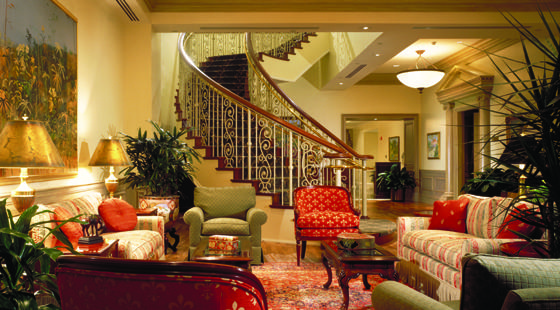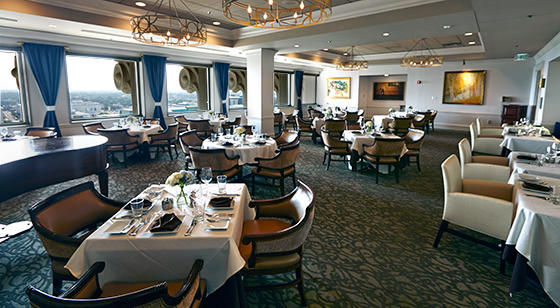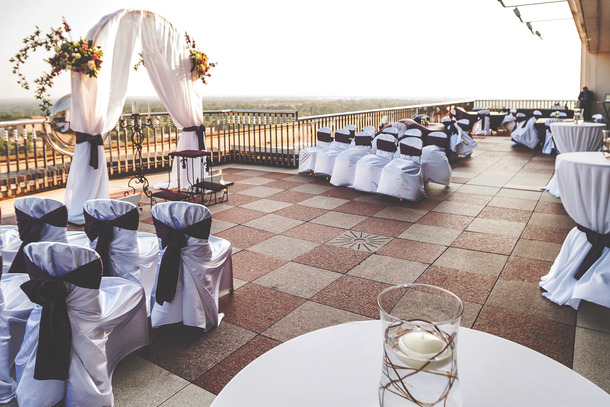 The CCC, as we called it, was actually an arm of Club Corp of America, headquartered in Dallas, and which owned some 230 national and international private clubs. In 1992, when the Tower episode began, CCC was located on the top (3rd) floor of the old Pizitz Department Store building on Court Square. There it had a magnificent view up Dexter Avenue toward the State Capitol. It also boasted convenient parking and an interior embellished with rich dark wood. My daughter Frances held her wedding reception there in November of 1988.
The CCC, as we called it, was actually an arm of Club Corp of America, headquartered in Dallas, and which owned some 230 national and international private clubs. In 1992, when the Tower episode began, CCC was located on the top (3rd) floor of the old Pizitz Department Store building on Court Square. There it had a magnificent view up Dexter Avenue toward the State Capitol. It also boasted convenient parking and an interior embellished with rich dark wood. My daughter Frances held her wedding reception there in November of 1988.
In early discussions of potential Tower tenants, the Capitol City Club came up, but Dr. Bronner vetoed the possibility, saying that the RSA was not going to steal such a private enterprise tenant from the Aronov machine. Within a year, however, Club Corp learned of the Towers’ eminent rise, and approached the RSA. That circumstance seemed to clear up any political or ethical hurdles, and CCC immediately replaced the meeting room complex that had been previously envisioned for the top floor.
Dealing with the giant corporate entity, and with its in-house design staff, was not at all pleasant. The challenge added more than its fair share of pain to the Tower ordeal. There was the constant changing of designers on Club Corps’ staff, the naiveté of that staff which led us to believe they never went back to see if their design details actually worked, the green stain fiasco, even the daunting problems of getting rid of the grease-laden cooking hood fumes at the top of a high-rise building.
 PH&J demanded a full design fee for the work, even though the layouts, decor, and details were all produced by the tenant from its Dallas headquarters. As I insisted to the RSA, we expected that it would cost us more to carry out Club Corp’s design than to produce a scheme of our own. As it turned out, that prediction proved to be devastatingly correct.
PH&J demanded a full design fee for the work, even though the layouts, decor, and details were all produced by the tenant from its Dallas headquarters. As I insisted to the RSA, we expected that it would cost us more to carry out Club Corp’s design than to produce a scheme of our own. As it turned out, that prediction proved to be devastatingly correct.
To my subsequent dismay, Club Corp appointed a group of local club members to advise them on decor appropriate to the region. According to the CCC newsletter, this group together with some of the Dallas staff “toured selected houses to get a local flavor for the interior design”. Translated, that meant that all the very expensive trim, paneling and doors in the new club would be of wood painted white, and would not be in rich natural finish mahogany or cherry as was featured in every other club. After all, they said, southern mansions were painted white and were not mahogany.
The Capitol City Club fit-out work, painted wood and all, was bid in October of 1995 and awarded to HH&N for a sum slightly below $3 Million. As was the case for the AmSouth work, Huber-Hunt could ill afford to bid high and thus allow another contractor onto the site. I found the results of the “southern design” to be much less than impressive, and I still yearn for the rich-feeling materials of the old club down on Court Square.
Embarrassing Delays
As a member of CCC, I received all its newsletters and bulletins. Thus I would read with great interest and alarm all the exaggerations of decor and predictions of moving that the Club was putting out. It was using the upcoming relocation as a great opportunity to recruit new members.
 A Kim Sutton was Director of construction for Club Corp in Dallas, and in May of 1996, he called for a meeting with Ron Blount and me to verify that the local Club’s projected move and grand re-opening in the approaching August was correct. August 13th was HH&N’s official contract completion date for the CCC work. Blount said, “Absolutely, they’ll be ready.” I told Sutton, “No way,” arguing that the building itself would never be ready by then. The Club official did not know which of us to believe, but CCC put out a bulletin to their members announcing an August opening. They even held a “hard-hat party” within the partially finished space to blow the horn for prospective members and the club elite. As August approached, it became obvious that I was right, and the Capitol City Club was sorely embarrassed.
A Kim Sutton was Director of construction for Club Corp in Dallas, and in May of 1996, he called for a meeting with Ron Blount and me to verify that the local Club’s projected move and grand re-opening in the approaching August was correct. August 13th was HH&N’s official contract completion date for the CCC work. Blount said, “Absolutely, they’ll be ready.” I told Sutton, “No way,” arguing that the building itself would never be ready by then. The Club official did not know which of us to believe, but CCC put out a bulletin to their members announcing an August opening. They even held a “hard-hat party” within the partially finished space to blow the horn for prospective members and the club elite. As August approached, it became obvious that I was right, and the Capitol City Club was sorely embarrassed.
Against my subsequent advice, the grand opening date was reset for October 12th, and a black tie event was scheduled to celebrate the occasion. Other major functions, as in wedding receptions, were booked beginning October 14th. I learned of all this via newsletters which came as a result of my membership. I well knew that HH&N would not make that date either, but the RSA’s official landlord position was to stand on the Huber-Hunt prediction.
The local club had a new manager about this time, a nice lady named Helen Allen, and I was really concerned over the howls of protest she and the CCC would encounter if the grand opening was canceled at the last minute for the second time. And this said nothing of the half-dozen brides’ mothers who would become enraged at the late cancellation of their daughter’s wedding reception. Late in August, I asked Mrs. Allen if we could speak confidentially. “Neither HH&N nor the RSA will admit it,” I warned her, “but there is no way the City will allow your club to open on October 12th. The building life-safety systems will not be ready.” I pointed out that the Montgomery Fire Department was still paranoid over the Dale’s Penthouse fire, which killed a dozen people in 1967. “They will test every bell and whistle in the entire building before an Assembly Occupancy is allowed to open on top of another building.”
I went on, “Both Capitol City Club and my client, the RSA, will be acutely embarrassed. Please rescind your announcement.” The lady became terribly distressed and sought instructions from Dallas. After a few weeks to overcome its own disbelief, the CCC admitted to its membership that their grand opening would be delayed again, this time until early in 1997.The worst possible scenario had befallen the Club. It would still be in the old building during the Christmas season and most of the special holiday bookings would have to be canceled. It was a plu-perfect disaster, so bad that Club Corp filed suit against the RSA. I’m still unsure if the matter is settled.
-Charles Humphries (“Peril and Intrigue Within Architecture”)
This is one of many RSA Tower stories. The rest can be found here.